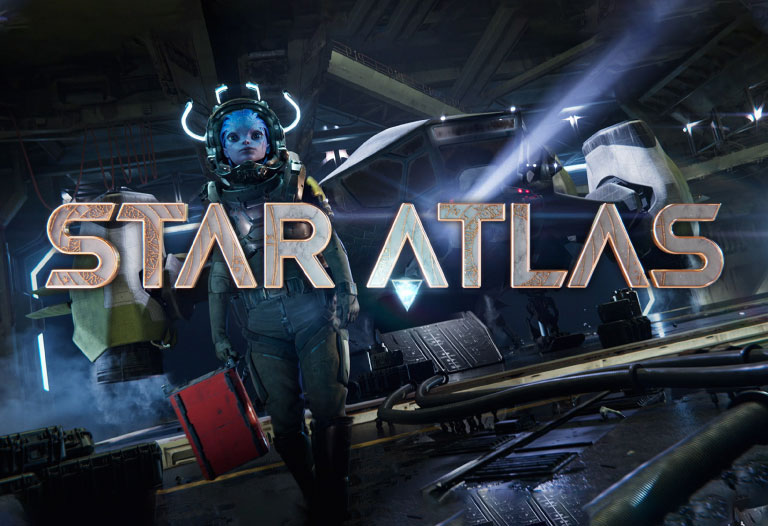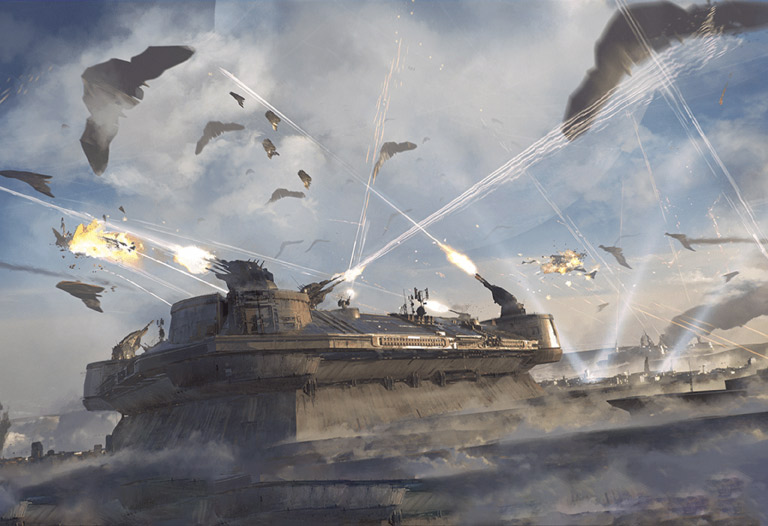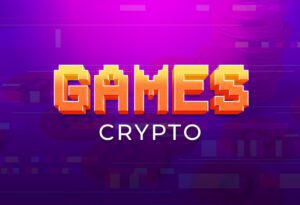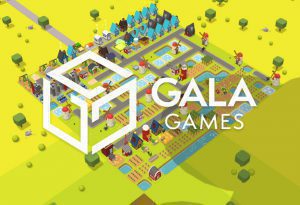
Table of Contents
ToggleI would like to begin this article by stating that Star Atlas is the natural evolution of the crossing of two gigantic worlds.
Since its inception, blockchain technology was destined to link its path and empower the world of gaming. With the advent of NFTs, a scenario began to be imagined in which users would own the characters and elements they use in a game.
CryptoKitties, was the first sketch of what this combination could become. Its effect, quite clearly, was the first time the Etheruem network collapsed.
Why do I think Star Atlas is the next step on this path? Because, in my eyes, we are facing the most ambitious game, to date, to be deployed on a blockchain. Join me in understanding what Star Atlas is.
So what is Star Atlas?
Star Atlas is a strategy video game built on the Solana blockchain. It is characterized under the AAA rating, which I will explain shortly. Its theme is centered in the distant future, in the year 2,620.
We can define it, from a point of view more related to our ecosystem, as a massive multiplayer metaverse that comes with what turns out to be a great innovation for this type of games.
We are used to coming across P2E games or metaverses, whose graphics are perhaps perceived as a little behind the times. But this is not the case with Star Atlas.
The development of the graphics of this metaverse is powered by the technology provided by Nanite of Unreal Engine 5. This is the engine that allows the creation of video games with cinematic quality visual experiences and extremely realistic textures and lighting.
Let’s review, its categorization in the gamer world.
What is a AAA game?
This classification began by including video games produced and marketed by major video game distributors or publishers with a large marketing budget, with the aim of obtaining high returns.
However, back in 2010, the classification of a game as AAA began to be used to define massively multiplayer online games or, defined by its acronym in English, MMOG.
The latter are video games that take place in a virtual world, which in this ecosystem we call metaverse. Another characteristic is that these games are played simultaneously by hundreds or thousands connected online.
Given these particularities, it is logical that the developers of Star Atlas have chosen the Solana blockchain to support the large number of simultaneous participants that will meet in this metaverse.
Structure and scalability
As I mentioned at the beginning, Star Atlas is a game set in a future society, precisely in the year 2620.
The civilization, presented in the game, is divided into three different factions, which represent the groups that users will be able to join and defend their interests.
They are as follows:
-
- Humans, who control the MUD territory
- Extraterrestrials deployed in the ONI region.
- Sensitive robots, which are located in the Ustur sector.
- Humans, who control the MUD territory
As you can imagine, these different groups have a common goal, which leads them to confront each other in order to achieve total and definitive victory.
The three factions aim to achieve the domination of the entire Star Atlas metaverse. It is this purpose that gives versatility to the game, since it is not only about battles between spaceships, which there are and they are spectacular thanks to the marvelous graphics. Star Atlas players will try to generate the best political, exploration and war strategies to advance towards the objective.
Now, after this not-so-brief introduction, let’s take a closer look at the game’s roles and activities, as well as a review of its tokenomics.

How to play Star Atlas?
I will try to summarize the options that players will enjoy as the development of Star Atlas and the various milestones, marked as releases, are reached.
Upon joining Star Atlas, participants will become citizens. Citizens, who will seek to contribute to the victory of the team or faction they have joined, can achieve this goal by engaging in battles, exploring the metaverse for resources or participating in the creation of political strategies to dominate the metaverse.
Now, let’s analyze the possibility of participation in the game.
How can I enter the game?
There are two ways to enter the game. The first, and the one that is currently the most attractive, is by acquiring a ship. The second option is by acquiring the game tokens, ATLAS.
– Acquire a ship
They are usually offered at auction-type events, such as the successful auction held last September 7. Today, any user looking for this experience can purchase a ship on the official marketplace.
I must warn you that the prices oscillate between very distant bands. We can find ships from as low as $15 to as high as $100,000.
It is also worth mentioning that there are ships for all tastes. From small and fast, ready to enter the hidden corners of the metaverse, to massive galactic liners, ready to destroy anyone who gets in their way.
What makes this game so interesting is that although the ships have their basic configurations, users will be able to acquire NFTs that will provide their possessions with new functionalities.
– Get your tokens
ATLAS, the token of this metaverse, will give you the possibility to make in-game payments, which will be necessary for your daily life. This unit of exchange will allow you to fulfill your obligations such as acquiring fuel for your ships, contributing to your taxes and paying for services.
What roles can I play in Star Atlas?
To get an idea of what’s to come, let’s take a look at the most prominent roles in this exciting metaverse.
– Miners
They will be in charge of extracting the raw materials that make it possible to start up the rest of the activities in the game. Also, they will be in charge of obtaining unknown resources in the metaverse.
To understand the logic of Star Atlas and the interactions that will take place throughout the game, the miners will depend on those who get energy to carry out their extractions and will have to pay a maintenance cost in the form of a tax for the land on which they carry out their work.
That’s right gentlemen, taxes will not continue until within the metaverse!
– Refiners
They are those who follow the miners in the productive chain of the game. These characters will be in charge of transforming the raw materials extracted by the miners into usable resources in the metaverse. These guys, too, will not escape from paying taxes…
– Managers
Ignoring our impetus to decentralize everything, managers appear in Star Atlas. They will be in charge of managing the use of resources and ensuring their efficient use.
– Scientists
In my personal opinion, one of the most interesting roles. Scientists, just as in real life, will be at the forefront of research that will provide new ways to use resources or even lead to the discovery of new materials with which to take an evolutionary advantage within their faction.
– Pirates
Another role, reflecting the history of mankind. No resource or raw material will be safe in Star Atlas. Pirates will not allow any faction to rest on its laurels and will try to get their hands on all resources that are not properly guarded.
– Builders
Finally, although there are even more roles, I will mention this group that deserves recognition. The builders will be in charge of supporting all the previous activities, creating the necessary structures for their “team” to progress in the game. Undoubtedly, this dedicated role will be fundamental to achieve victory.
What levels are there in Star Atlas?
Much of this metaverse is organized and developed in different levels. Within the game there are three, and these are related to the degree of difficulty and risk that they will present to the citizens. Of course, here the rule of “the greater the risk, the greater the benefit” will remain intact.
Let’s see what these three levels in Star Atlas are all about and go from the safest to the most dangerous.
– Safe area protected by factions
Its name suggests it. In this area, citizens will be able to explore the metaverse and engage in all kinds of activities safely. Obviously, in this area, exploration will be the main focus.
– Medium level security zone
After passing them in the previous area, when you are confident and your skills have increased, it’s time to go out to this area. Here the ships you face will be controlled by bots.
These will be more or less difficult to defeat according to the level they have, but in this area you will not face losing your goods, as it may happen once you cross the borders…
– Beyond the wild frontier
Perhaps the introduction above said it all about this area. Anything can happen here, the risk is enormous but so will be the rewards..
Outside the borders, the battles will be extremely real and the reality, as we know, is savage. In these battles, the parts of your ships that are destroyed will be turned into scrap. And that itself will be their value.
Beyond the material losses, these ships must have their own crew, which will occupy different roles, such as those mentioned in the previous section. A fierce defeat in a battle may result in losses of personnel, which can be extremely expensive…
Outside the border is where the real action will take place.

Star Atlas and its tokenomics
Such a staging, both technologically, visually and in terms of narrative, must be accompanied by a solid economic vision. Let’s not forget that this is a game in which participants will seek to obtain economic benefits.
That is why Star Atlas has its own token identified with the ticker ATLAS. Of course, it will be the exchange currency within the platform, with which the NFTs that are used within the game can be acquired.
With a total supply of 36 billion tokens, although it is an inflationary token, it has burning mechanisms, which will allow balancing the amount of circulating currency and maintaining a healthy stability.
However, ATLAS is not the only token related to Star Atlas. In their roadmap, there is the vibrant goal of being a decentralized game and they seek to achieve it, by using POLIS, the Star Atlas governance token, which will have a total supply of 360 million.
It goes without saying that through it, users will be able to make all the decisions about the future of this ambitious video game.
However, the team behind this project is prudent and understands that both the full development of the game and the decentralization through a DAO will require a long period of time. Therefore, the issuance of both tokens is planned to be completed in 8 years.
A look into the future
The future of metaverses is marked by the pace of Star Atlas. Not only from the graphic and narrative perspective, but also from the economic aspects.
Star Atlas is connected to Serum DEX, which will allow its users, through decentralized smart contracts, to interact directly with the DeFi ecosystem. Fast loans, deposits and exchanges are on the horizon for Star Atlas players.
Today it is not far-fetched to imagine thousands of people living off their interactions in blockchain-based metaverse. Star Atlas will certainly play a very interesting role in this regard.



